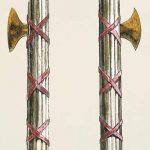The ‘Great Trek’ was the massed movement of Boer (Dutch/Africans) farmers to the north out of the Cape Colony into the Orange Free State, Natal and Transvaal in the 1830s. The Boers had resented the British ever since the end of the Napoleonic Wars, when they took over the Cape from the Dutch settlers. They disliked new laws which prevented them from buying or keeping slaves, and they equally disliked what they saw as soft treatment of black people in the courts. Therefore trekboers wanted not only to get away from British rule but also to find more land – and new sources of labour; several thousand people migrated northwards across the Orange River and into lands still controlled by blacks.
In Natal, a Boer party led by Piet Retief visited a Zulu chief called Dingane in his kraal, where they assumed they would be welcome. They met treachery however, and the party was cut up by the tribe at the direction of Dingane.
Other Boers, furious and determined on revenge, formed a ‘regiment’ (the first mention of the word commando) of nearly five hundred trekkers under the command of Andries Pretorius. The Boers had already perfected the ‘circle of wagons’ technique which would be used later to such good effect by the North American pioneers crossing lands inhabited by hostiles. The trekkers’ wagons would be tied tightly together in a circle, leaving two or three openings where cannons could be placed and fired. Zulu war parties found the Boers near the Ncome river and assaulted them. The Boers instantly formed their laager and primed their weapons.
Rank upon rank of Zulus (more than ten thousand) attacked the laager but were shot down en masse by cannon fire and the always accurate rifle-shooting Boers. It is recorded that the cannons were not only loaded with balls, but also grape-shot, which cut a swathe through the ranks yards wide. The black warriors never reached the wagons.
Their chief ordered a retreat, but it was useless, as out of the laager rode mounted Boers who could shoot using both hands, controlling the horse with their knees. These mounted men carried out a frightful slaughter among the running natives; those who looked for shelter from the murderous fire took refuge in a canyon but it was useless. They were hunted down and massacred. It is recorded that more than three thousand Zulus died on that day at ‘Blood River’ (the Ncome). It was December 16, 1838: this day has always carried much significance for Afrikaners, who believe that their faith in God protected them from their enemies.
One of the long-lasting results of this bloodstained incident was that Boers and Zulus maintained a mutual loathing for each other which has not relaxed, even today. South Africa’s Boer-descended leaders tried for years to keep blacks and whites separated by Law in South Africa. Apartheid was invented by Dr Verwoerd when he was Minister of Native Affairs in South Africa between 1950 and 1958. He met his end assassinated in the Parliament itself.










Gerald, thank you for your Comment and your commendation of our Site
Dean Swift.